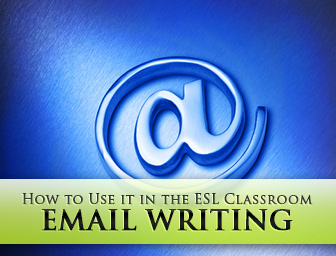How to Use Email Writing in the ESL Classroom


Perhaps the technology was too new for teachers and students to put to practical use. Perhaps it was for other reasons. But even though I had an email account with my school, I didn’t use it for anything other than social notes. Enter the twenty-first century. Classrooms today are different than they used to be. Technology is everywhere, including each of our pockets. Phones can do email, surf the web, and access more information than we could ever use in class even if we had a thousand years to do it. Technology is as familiar to many of us and our students as breathing. That’s why classrooms today are not what they were when I was in school and why using email with your students is now a good idea. Even if you haven’t used email in class before, now might be the time for you to start. Here are thirteen easy ways you can incorporate email into your ESL class.

Email is good for more than just writing class. Send out discussion questions to your students via email. They will still be able to reference them as they talk with their groups, but you don’t have to take time to make copies or worksheets for your class. You’ll be saving valuable resources, too. You can also email role play assignments and other in class materials for students to use.
While you are at it, send students homework via email. Students will have their to do list with them wherever they go and no one will be able to use the excuse they lost their homework or forgot the assignment.
Rather than printing out articles from the internet and copying them for your students, send a link via email and save time and money. Plus give your students some practical experience navigating the net in English.
Emails are great resources for sequencing activities. Take an email and cut the sentences apart. Then challenge your students to put the lines in order using context clues.
Even better than sequencing lines in one email, print out a series of emails (make sure you remove the time signatures and memo lines). Have students put the series of emails in logical, conversation order.
Email is a great practical writing assignment that even high beginning and low intermediate students can do. Have them send a letter of complaint or compliment about a product they have experience with to a company’s customer service address.
Do you ever have your students race to find information in a reading assignment? If you do, have them send the answer to you via email. You won’t have to watch to see whose hand goes up first. You will have an indisputable time stamp on the email that will prove who is the winner.
Have students work with each other over email to set up some hypothetical social meetings. Have students email each other to set up two hour appointments over a three day period. Students will email each other and then respond to set up their dates. After a date is confirmed, have students write it on a calendar. Give students a set amount of time in class to set up their appointments. At the end of the period, the person with the most confirmed meetings is the winner.
Do you use mysteries or logic puzzles in class as conversation activities? If so, try emailing different clues to each student in your class. Start by sending everyone an email with the general setup or situation they will be trying to solve. Then give different clues to each person in class or to different groups of students in class. Your students will have to walk around the room and talk to each other to get all the clues before they can solve the mystery or logic puzzle.
Subscribing to blogs is a great way to learn about something new. The information comes right to your inbox. Have students sign up for a blog (they can choose any topics but try to avoid letting students subscribe to blogs about their home countries). After one or more posts, have your class share what they learned from their blog subscription either in a short presentation or in writing.
Send two versions of the same email to each half of your class (each with minor differences such as Dear Sir vs. Dear Sir or Madam). Then have students work with a partner who got the other email. They can read the emails together and spot the differences between each version. As they locate each difference, have students decide if it changes the meaning of the email.
Send two versions of the same email to half of your class, but this time put several different grammar errors in each one (such as punctuation, verb tense, or subject verb agreement). Have students work together to find the mistakes in each email.
Having students give each other feedback on presentations is a great way for them to use their English. After one person gives a presentation, have each member of the class send them a short email with feedback. In the email, they should write what the person did well along with any questions they have about the information that was presented.
Email is a great resource for ESL teachers and students. Try one or more of these ways to include in it in class and see the benefit that both you and your students get.
What are your favorite activities to include in class?